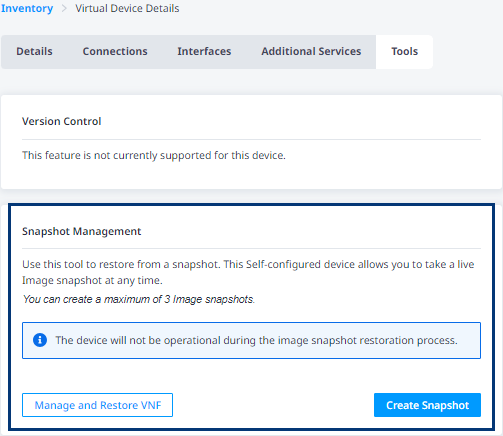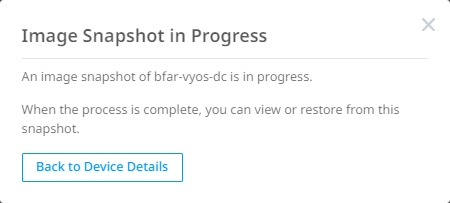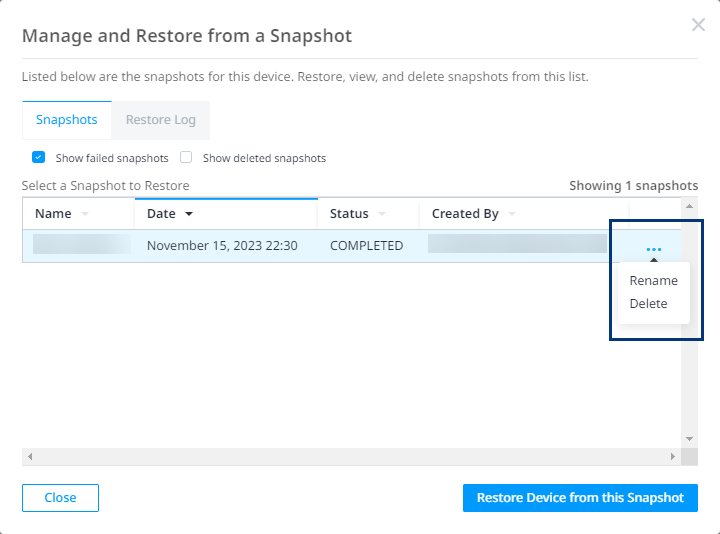Snapshot and Restore
Image Snapshot and Restore
This topic describes the Snapshot and Restore function that allows you to take a snapshot of your self-configured device image, then restore the VNF by re-provisioning the image with a backup. A maximum of 3 snapshots are allowed per VNF. The backup image cannot be downloaded and it is only available to restore in the Network Edge infrastructure.
The Snapshot and Restore function requires a device downtime of up to 90 minutes depending on the device attributes.
Supported functions of Snapshot and Restore include:
- Snapshot and Restore is only available for self-configured devices.
- Snapshot and Restore is not available for Equinix-configured devices.
- The VNF needs to be shut down before creating a backup. Users should expect service interruption of 60 to 90 minutes. It is highly recommended that you schedule a maintenance window before you start this process.
- Only 3 snapshots can be saved as backup per VNF. Older backups need to be deleted before creating a new one if the limit is reached.
- For Cluster deployment, 3 backups per node will be allowed. Both nodes need to be backed up at the same time.
- Primary and Secondary image snapshots cannot be taken simultaneously. Only one device can be backed up at a time so that the other device can assume the active role.
- The restore function requires deletion of the current VNF. If any resources such as Connection and Device Link Group are deleted after the image snapshot is taken, the device will not be restored.
Feature availability is based on the VNF type and the IBX in which the VNFs are provisioned. Refer to the following table to see if your VNF supports snapshot and restore features. For some VNFs, you need to disable and then re-register the license due to the internal identifier changes during restoration process.
| VNF Type | Snapshot and Restore Support | Required User Action |
|---|---|---|
| Any VNF provisioned in the AM4, FR6, LD6, CH1, DA1, DC11, SV5, SG3, SY4 | No | N/A |
| Aruba EdgeConnect | Yes | No action required |
| Arista CloudEOS | Yes (BYOL) | No action required. VNF should retain the license after restoring |
| Aviatrix Edge | Yes | No action required |
| BlueCat | Yes | No action required |
| Check Point Firewall | Yes (BYOL) | No action required. VNF should retain the license after restoring |
| Cisco CSR1000v | Yes (BYOL) | User should de-register and register with the smart license after restoring |
| Cisco CSR1000v SD-WAN | Yes (BYOL) | User should de-register and register with the smart license after restoring |
| Cisco Catalyst 8000V (Autonomous Mode) | Yes (BYOL) | User should de-register and register with the smart license after restoring |
| Cisco Catalyst 8000V (Controller Mode) | Yes (BYOL) | User should de-register and register with the smart license after restoring |
| Cisco FTDv | Yes (BYOL) | User should de-register and register with the smart license after restoring |
| Cisco ASAv | Yes (BYOL) | User should de-register and register with the smart license after restoring |
| F5 | Yes | No action required |
| Fortinet FortiGate vFW / SD-WAN | Yes (BYOL) | No action required. VNF should retain the license after restoring |
| Infoblox NIOS | Yes | No action required |
| Infoblox Grid Manager | No | N/A |
| Gigamon V-Series | No | N/A |
| Juniper vSRX | Yes (BYOL) | No action required. VNF should retain the license after restoring |
| NGINX Plus | Yes (Subscription) | No action required. VNF should retain the license after restoring |
| Palo Alto Networks VM-Series Firewall | Yes (BYOL) | User should de-register and register their license after restoring |
| Palo Alto Networks Prisma SD-WAN | No | N/A |
| Prisma SD-WAN | No | N/A |
| Check Point Firewall | Yes (BYOL) | No action required. VNF should retain the license after restoring |
| VERSA | Yes (BYOL) | No action required. VNF should retain the license after restoring |
| VMWare SD-WAN | Yes | No action required |
| VyOS | Yes (Subscription) | No action required. VNF should retain the license after restoring |
| Zscaler | Yes | No action required |
Create a Snapshot of VNF Image
-
From the Network Edge menu, select Virtual Device Inventory.
-
Select the self-configured device you want to create a snapshot for and then click Tools.
-
In the Snapshot Management card, click Create a Snapshot.
 info
infoThe device will not be operational during the image snapshot process. Plan your maintenance window (up to 90 minutes) to avoid any service interruption.
-
In the Create Image Snapshot prompt, enter a Name for this back up image and select I am aware that device operations will be limited during this process. Be aware that estimated time to complete the snapshot may vary based on the size of the VNF.

-
Click Submit to start the snapshot process. Another prompt displays indicating that the image back up is in progress. Click Back to Device Detail or X to close this prompt.

In the Tools section, the Snapshot Management card indicates that the Image Snapshot is in progress, and shows an estimated time for completion. Device status indicates Image snapshot is in progress.
-
In the Snapshot Management card, click Manage and Restore from Snapshot to manage your backups.

-
Rename or delete your snapshot by selecting the image and then clicking the edit icon to make a selection.

Restore VNF
Once the restoration process begins, it cannot be undone. We recommend you create a backup of the current state of the device in case any change to the VNF needs to be saved.
-
From the Network Edge menu, select Virtual Device Inventory.
-
Select the device for which you want to create an image backup, then click Tools.
-
In the Snapshot Management card, click Manage and Restore from Snapshot. All of the snapshots will display.
-
Select the image you want to use to restore and click Restore Device from this Snapshot.
-
Click Restore Now in the Create a Snapshot Before Restoring (Recommended) prompt.

After the restoration process is started, your device will not be operational for 60 to 90 minutes. Your device status will indicate that the restoration is in progress.